|
TUESDAY EDITION January 6th, 2026 |
|
Home :: Archives :: Contact |
 |
Uranium Stocks ComparedAlf Field February 28, 2005
Owners of uranium stocks have profited mightily over the past 6/12 months. The strong outlook for uranium prices is becoming more widely appreciated and accepted while the dearth of available companies through which to participate has added to the price momentum. Morgan Stanley's "Basic Materials: Global Insights" Equity Research Report contained a section entitled "Supply/Demand Outlook: Uranium Oxide - Inventory Cycle Coming to an End”. Some of the highlights from the report: Spot prices for uranium are forecast to average US$45 in 2006, while long-term contract prices are forecast to be in the range of US$46-$49. The end of supply from nuclear weapons decommissioning is forecast. This has been the source of up to 45% of recent global supply. Forecasting the supply-side deficit to peak in 2006 @ 17,950 tons (40m lbs), or 25% of global demand. Current mine production accounts for only 53-55% of demand. Demand side is growing rapidly - 35 nuclear power reactors are in the planning stages, another 35+ being proposed. South Korea - 8 under construction Japan - 3 under construction, 12 planned China - 4 under construction, 6 planned, 20 more proposed India - 9 under construction, 24 proposedFor a more detailed review of the prospects for uranium, check the following article by Eric Sprott: http://www.321energy.com/editorials/sprott/sprott021805.html This article was written in September 2004 but is a topical, accurate summary of the forces that are in play in the uranium market. There have been rumours of recent long-term contracts in the region of $27 lb. If the Morgan Stanley forecast of contract prices of $46-$49 and upwards for next year is correct, then the chart for the coming 12 months should produce a continuation of the trend in the above chart. There are probably upwards of 500 companies involved in the gold and silver markets but there are less than a couple of dozen companies that own or have the potential to discover and mine uranium. The balance of this report depicts the share price performance of some of the better known uranium companies and endeavours to make some a comparison between them in an effort to identify uranium stocks that are currently undervalued.
Cameco (CCO in Toronto) Web site: www.cameco.com Cameco is the major investment grade stock of the uranium industry. Issued share capital: Current – 173m shares x C$55.00 = C$9,500m (US$7,600m) Cameco is the largest supplier of uranium in the world accounting for about 20% of annual demand. Proven/probable reserves are of the order of 550m lbs. Cameco owns 31% of Bruce Power, supplying electricity to Ontario from nuclear power plants, and 53% of Centerra Gold. 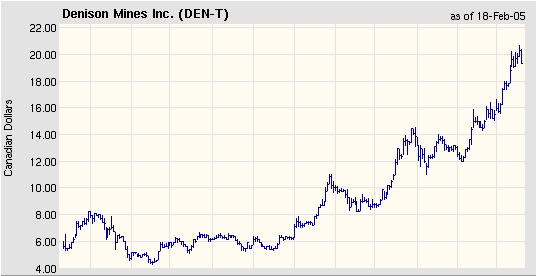  Denison Mines. (DEN in Toronto). Web Site: www.denisonmines.com Issued Share Capital: 24.9m x C$18.4 = C$458m (US$367m) Denison is a uranium exploration, development and production company. Major assets are 22.5% of the producing McLean Lake Uranium Facility and 25% of the Midwest Uranium deposit. Denison’s share of uranium reserves and resources is currently 13.5m lbs. 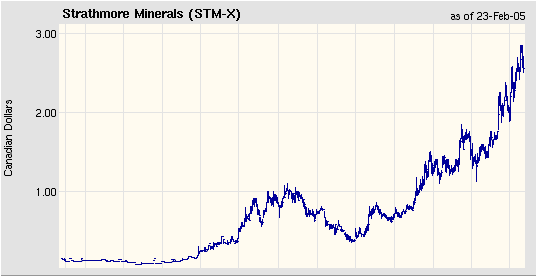  Strathmore Minerals. (STM in Canada) Web Site: www.strathmoreminerals.com Strathmore’s strategy has been to acquire known but un-mined deposits of uranium and hold them while drilling and advancing permitting, thereby offering leverage to the uranium price. Countries covered are USA, Canada and Peru. Sprott Asset Management holds 25% of STM. No reliable estimates of the uranium resources owned by STM are available but historical records suggest that they may be between 100m and 200m lbs. Cash available for working capital is of the order of C$24m following the latest placement at C$1.75. Issued Share Capital: Current - 45.1m x C$2.55 = C$115m (US$92m) Fully diluted – 64.4m x C$2.55 = C$164m (US$131m) 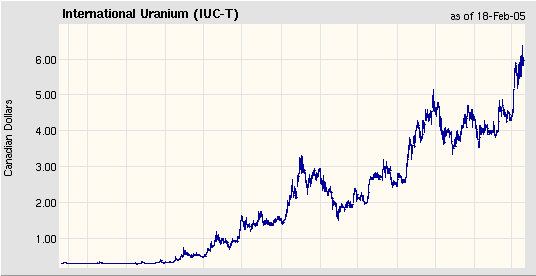  International Uranium. (IUC in Toronto). Web Site: www.intluranium.com Issued share capital: Current – 77m shares x US$5.72 = US$440m Fully Diluted - 79m shares x US$5.72 = US$452m International Uranium’s major assets as described on the company’s web site are: 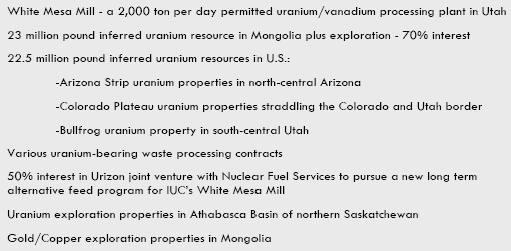
JNR Resources. (TSX Venture - JNN) Web Site: www.jnrresources.com. The following summary is from the company’s web site. JNR Resources is a junior mineral exploration company based in Saskatoon, Saskatchewan, Canada. JNR’s objective is the acquisition of prospective natural resource properties, and the exploration and development of those properties. JNR is currently engaged in the exploration and development of uranium and gold properties in the Province of Saskatchewan. The uranium deposits of Saskatchewan are arguably the richest deposits of any type in the world. For example, Cameco's McArthur River deposit has proven and probable reserves of 801 thousand tonnes at an average ore grade of 23%, or 437 million pounds U3O8. JNR's major focus is its Moore Lake Joint Venture near McArthur River, where a significant zone of mineralization (up to 20% U3O8) has been identified at the Maverick Zone. Issued Share Capital: current – 62m shares x C$1.15 = C$71m (US$57m) Fully diluted – 72m shares x C$1.15 = C$83m (US$66m) 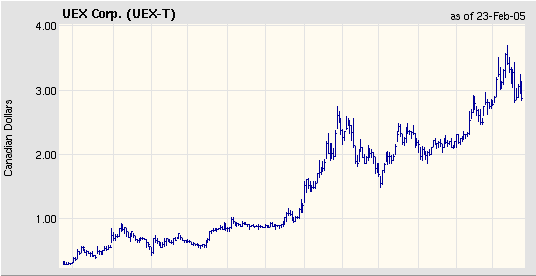  UEX Corporation. (UEX in Toronto). Web Site: www.uex-corporation.com Issued Share Capital: Current – 146m shares x C$3.00 = C$438m (US$350m). Fully Diluted - 160m shares x C$3.00 = C$480m (US$384m) UEX is a uranium exploration company formed under an agreement between Pioneer Metals Corporation and Cameco. Cameco is UEX's largest shareholder (26%) and manages exploration at UEX's Hidden Bay Project. UEX began trading on the Toronto Stock Exchange in July 2002 and is actively involved in the exploration and development of uranium projects in the Athabasca Basin. UEX has 13 uranium projects either 100% owned, joint ventured or under option totaling approximately 328,000 hectares (811,000 acres) located in the eastern, western and northern perimeters of the Athabasca Basin, the richest uranium belt in the world.
Energy Metals. (EMC). Web Site: http://www.energymetalscorp.com/s/home.asp Issued Share Capital: Current -18.9m x C$3.22 = C$60Mm (US$48m) Fully diluted – 23.2m x C$3.22 = C$74m (US$60Mm) EMC has been acquiring known, previously mined or already explored deposits of uranium, mainly in Wyoming. Historical records suggest that EMC owns a total resource of 68.8m lbs, but these figures are not NI 43-101 compliant and need to be verified by the company. 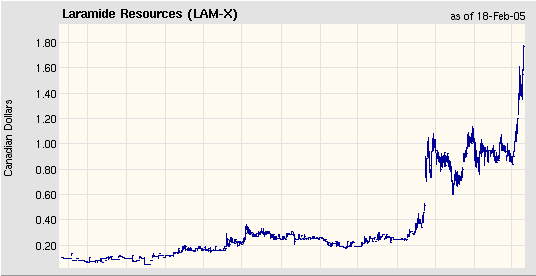  Laramide Resources. (LAM in Canada) Web Site: www.laramide.com Issued Share Capital: Current – 32.6m x C$1.78 = C$58m (US$46m). Laramide’s current focus is the advancement of its Westmoreland Copper/Gold/Uranium Project in Queensland, Australia, which is expected to become Laramide’s flagship asset. The Company considers Westmoreland (previously owned by Rio Tinto PLC) to be a development stage asset, as it has been the subject of extensive drilling as well as a pre-feasibility study since its discovery in 1956. Westmoreland has a large existing resource of 17.4M tons @ 1.2 kg/ton U3O8 (>40 million pounds) which ranks it as one of the top ten largest uranium deposits in Australia. This resource estimate was completed in the mid 1990’s, prior to the implementation of National Policy Instrument 43-101, and therefore is not presently compliant. It does however provide a useful comparative context particularly given that Australia hosts the world’s largest known uranium resources with a 28% global market share. WMC Resources. (WMR in Sydney) Web Site: www.wmc.com WMC is one of the largest producers of nickel and copper in the world and, in addition, accounts for approximately 10% of the world’s current uranium production. WMC is also a major fertilizer producer. At current production and price levels, nickel accounts for nearly 60% of revenue with copper contributing about 25%. Uranium provides a mere 5% of revenue with fertilizer accounting for about 10%. WMC plans a major expansion of its Olympic Dam operation which is mainly copper and uranium. Even after this expansion, nickel and copper will still be the major main stays of WMC revenue stream with uranium delegated to the role of a by-product. Despite being a major player in the world uranium market, WMC cannot really be taken as a serious way to participate in any major uranium price rise. Xstrata is currently bidding to take control of WMC. WMC has a market capitalisation of the order of US$7 billion. 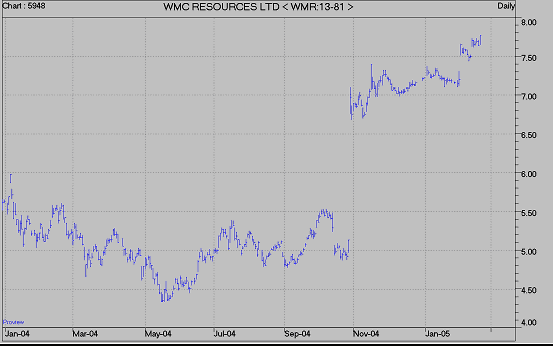 Goldstream Mining. (GDM in Sydney) Web Site: www.goldstreammining.com.au Issued Share Capital: Fully diluted – 130m shares x A$42c = A$55m (US$43m) Goldstream has established exploration infrastructure in Australia, Tanzania and India. In April 2004 GDM acquired an advanced portfolio of projects from Anglo American including multiple nickel targets in Australia and India. Anglo American is the largest shareholder in GDM with about 7.5% of the share capital. Lonmin is a farm-in partner in the Luwumba platinum/nickel/copper project and will earn 70% interest in this project by funding all the exploration to completion of a feasibility study. GDM has many other projects, including some highly prospective uranium areas in both Australia and Tanzania. Thus far the uranium market “vigilantes” have not yet discovered GDM. This discovery cannot be too far away! 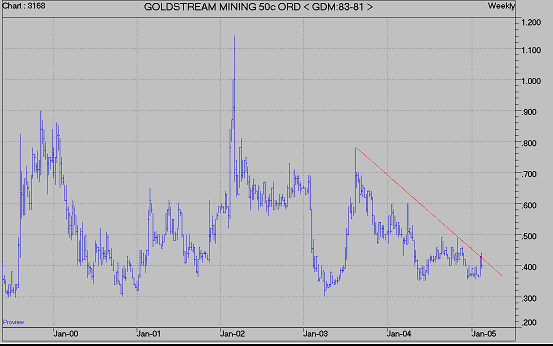 The following announcements were downloaded from the GDM web site: 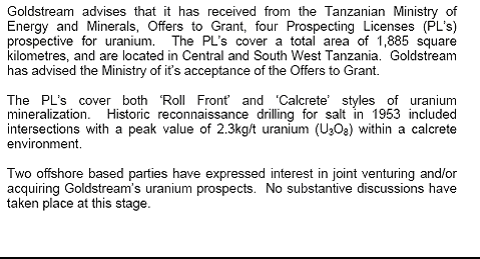
Paladin Resources (PDN in Sydney) IS a stock that the uranium market “vigilantes” did discover during the past year. I bought a holding in PDN a year ago at 6c. That is not a typo! Nine months later the share price pushed through 60c. A 10-fold increase in such a short time was too much for me and I sold my position. PDN recently nudged $1.20, a 20-bagger in exactly one year. PDN is surely a candidate for the stock of the last year. Web Site: www.paladinresources.com.au Issued Share Capital: 363m shares x A$1.10 = A$400m (US$315m) PDN has a uranium project in Namibia (with a bankable feasibility study nearly ready and an estimated resource of 50m lbs), another project in Malawi with 25m lbs and 2 Australian projects with about 35m lbs resources in total. The Presentation dated 11 January 2005 on the company’s web site is a model for other companies to study. It is a picture of clarity. Total uranium resources over all 4 projects are about 110m lbs. ---------------------------------------------------------------------------------------------------------------------------- 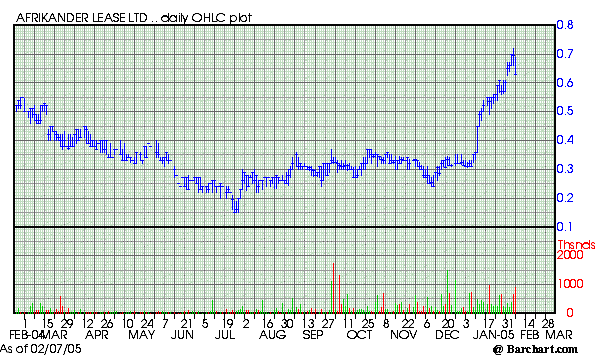 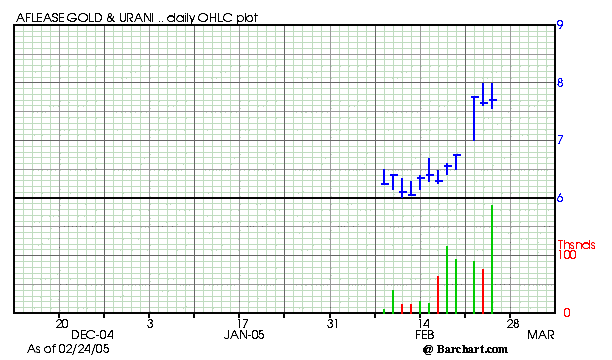 Aflease Gold and Uranium Resources. (AFL in Johannesburg; AFLUY on the Nasdaq Pink Sheets). Aflease is fast tracking a full board listing in Toronto and recently appointed Nesbitt Burns as sponsoring brokers for this listing. Web Site: www.aflease.com Aflease changed its name from Afrikander Lease to Aflease Gold and Uranium Resources. Following this change, the Nasdaq quote was consolidated 10 for 1 and the code was changed from AFKDY to AFLUY. The top chart is for AFKDY until the change. The second chart is for AFLUY following the change. $7.00 on AFLUY equals 70c on the AFKDY chart. Aflease owns a very large Uranium deposit in the Klerksdorp area of South Africa, known as Dominion Uranium, adjacent to its Bonanza gold mining operation. This deposit contains a target potential in excess of 300 million lbs of uranium oxide. This deposit represents about 6% of the world's uranium resource. This uranium deposit was previously mined in the late 1950’s and more recently in the late 1980’s. As such there is a significant amount of information on the resource. The resource already has in excess of 250 exploration boreholes, 47 000 data points from previous mining and a 3 dimensional model developed from a seismic survey. In addition Aflease is in possession of all previous metallurgical process design and has numerous access points to the orebody. With the recently completed 200 000 TPM CIL plant positioned immediately adjacent to the Dominion orebody and with a history of previous mining there is infrastructure in place to ensure an early start up. Aflease recently entered into an agreement in principle with Harmony Gold whereby Aflease would acquire the right to mine, process and market all of Harmony’s uranium in South Africa. This resource is estimated to consist of 155 million lbs U3O8 of high grade dump and tailings material, which could start producing uranium in about 2 years. A further 145 million lbs U3O8 low grade tailings has also been delineated as a future target. The Harmony uranium deposits are situated predominately to the west of Johannesburg and in the Free State province. These rights have been acquired for R200 million and payment to Harmony will be by way of Aflease scrip. In addition Harmony will receive a royalty as and when these resources are brought to account. By acquiring Harmony’s uranium interests, Aflease will have a uranium resource of more than 600 million lbs. This would place Aflease among the top international uranium companies. (Compare it with Cameco’s uranium resources of 550m lbs.) Assuming satisfactory due diligence on the Harmony deal, this deal will be completed and the issued Aflease share capital will increase to about 40m shares on the consolidated AFLUY basis. Harmony will then own about 15% of AFLUY. Other major shareholders are Trinity Holdings and Sprott Asset Management. Issued Share Capital: 40m shares x US$7.70 = US$308m. 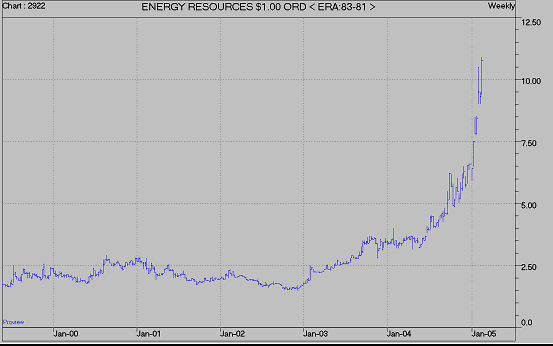 Energy Resources Australia. (ERA in Sydney) Web Site: www.energyres.com.au Issued Share Capital: Current – 190.7 shares x A$11.00 = A$2,097m (US$1,657m) The Ranger ore bodies were discovered in 1969 but it wasn’t until 1977 that an agreement allowing mining was signed with the Northern Land Council, representing the interests of the Aboriginal owners of the area. Construction at the Ranger site commenced in 1979 and the first drum of U3O8 was produced on 13 August 1981. Ranger has continuously operated since that time and ERA has grown to be the third largest uranium producer in the world. In 1991 ERA purchased the Jabiluka ore body from Pancontinental Mining for a cost of $125 million. As part of the ERA purchase of the lease from Pancontinental, the Northern Land Council, on behalf of the Traditional Owners, assigned Aboriginal approvals to ERA. In May 1998 ERA began consultations with the Northern Land Council (NLC), who act on behalf of the local Aboriginal people, in relation to the change in design of the Jabiluka proposal. Final Northern Territory approvals for the development of the mine were received in June 1998. ERA commenced stage one of development on 15 June 1998. This was completed on 4 July 1999 and included surface works, a water management pond and the exploratory decline. Following ERA's completion of stage one development in 1999, the 17-hectare development site (which includes surface works, a water management pond and exploratory decline) was placed on standby and environmental care and maintenance to facilitate further community discussion on the project. Since then, ERA has stated that there will be no further development at Jabiluka without the support of the Aboriginal people through their representatives, the NLC. . Reserves and Resources: Ranger resources are approximately 144m lbs (basis January 2005). Mining at Ranger is expected to continue until at least 2008, with milling operations to produce uranium oxide continuing until at least 2011. The Jabiluka deposit is estimated to contain approximately 320m lbs but there are question marks over its future. While ERA will be a beneficiary of the anticipated large uranium price increase, there is only limited life left in the Ranger deposit. The current market capitalisation of US$1.6 billion can only be justified if ERA is successful in proceeding with the mining of the Jabiluka deposit. The market seems to be betting that this will happen in due course. COMPARISONS AND CONCLUSIONS. The companies reviewed above are so different that it is impossible to find a formula for comparing them. There are exploration companies, companies that own older, known but uncertain deposits, companies that will be producing within a few years and also current producers. The fact that there are so few uranium mining/exploration companies probably ensures that they will all rise as the uranium price escalates. All one can do is examine some of the anomalies which suggest that a couple of stocks might be superior performers. For example, Goldstream Mining (GDM in Sydney) is a uranium explorer that has not been discovered by the uranium vigilantes. GDM has interesting prospects for uranium exploration both in Tanzania and the Northern Territory of Australia. I am told that the latter area has no Native Title problems, which is a big plus. With a small market capitalisation of US$43m, any good exploration news should add significantly to GDM’s market value. GDM seems to have limited downside potential and could warrant a small amount of gambling money. The companies that have purchased older, known deposits that have unreliable resource estimates, for example Strathmore (STM), Energy Metals (EMC) and Laramide (LAM), seem to be valued at US$1.00 per lb of uranium in the ground despite the lack of reliability of their resource estimates. Paladin (PDN in Sydney) which is approaching development of one project and has more reliable resource estimates, is being valued at $3.00 per lb in the ground. (PDN has a market capitalisation of $315m and 110m lbs of uranium resources). Aflease Gold and Uranium (AFLUY) will have well defined and confirmed resources in excess of 600m lbs assuming the Harmony acquisition is completed. With a market capitalisation of US$308m Aflease is being valued at a mere 50c per lb in the ground. The Aflease situation is analogous with that of Paladin, but the latter company is valued at $3.00 per lb in the ground. This analysis suggests that Aflease is undervalued relative to its peers. A comparison with UEX also suggests that AFLUY is undervalued. UEX has a market capitalisation of US$384m which is higher than the $308m that AFLUY is valued at. Yet UEX is still at the exploration stage while AFLUY has a reliable uranium resource of 600m lbs and should become a profitable producer within a couple of years. Energy Metals (EMC) with a market capitalisation of only US$60m looks the most attractive of those companies that have been acquiring older, known deposits. The latest EMC purchase of uranium properties in Wyoming looks especially interesting. Alf Field 27 February 2005 Disclosure and Disclaimer Statement: The author advises that he is not a disinterested party in that he has personal investments in the following companies: International Uranium (IUC), JNR Resources (JNN), Energy Metals (EMC), WMC Resources (WMR), Goldstream Mining (GDM), Aflease Gold and Uranium (AFLUY). The author’s objective in writing this article is to interest potential investors in these companies to the point that they are encouraged to conduct their own further diligent research. Neither the information nor the opinions expressed should be construed as a solicitation to buy or sell these or any stocks, currency or commodity. Investors are recommended to obtain the advice of a qualified investment advisor before entering into any transactions. The author has neither been paid nor received any other inducement to write this article. |
| Home :: Archives :: Contact |
TUESDAY EDITION January 6th, 2026 © 2026 321energy.com |
|